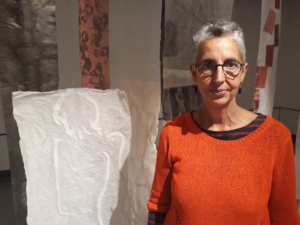Pip Woolf Explores Identity Through Dementia in New Exhibit

The notion of identity is explored in an exhibition inspired by the artist's experience of dementia.
Pip Woolf's Matter of Identity, on display at Warrington Museum & Art Gallery until Sunday 22 September, is a powerful exploration of how the condition affects how those living with dementia see themselves, and how others see them.
She challenges the public to take notice of these sometimes marginalised members of society.
"One in five of us will succumb to dementia," she said. "We use the word 'they' to describe them but we're throwing them away by doing so.
"I'm trying to reclaim identity."
Pip drew on personal experience of seeing loved ones live with dementia and Alzheimer's, and time spent as an artist in residence at an elderly mentally infirm (EMI) care home.
"The home is near a major trunk so hundreds of people go past it every day," she said, "and yet there are people living there who never get visited.
"There's a sense of these people being discarded, but it could be any of us."
Pip explained the use of layering in her artwork: "Matter of Identity isn't about dementia, it's about identity, it's about us.
"What's underneath the exterior? What happens to our identity when we have dementia?"
One of the most striking pieces of work on display is 'John', a series of connected double-glazed units which are engraved and articulated with aluminium leaf.
A glass panel which features the outline of John - a care home resident living with end-stage dementia - was accidentally shattered.
But the unintended effect brings into sharp focus the fragility of identity and highlights how easily an external force can shift our perception.
"When I accidentally knocked the toughened glass panel the sound and appearance were spectacular, bringing the piece into sharper focus even as it seemed to disintegrate, blossoming into more thoughts of identity.
"Identity too is fragile, often morphing from one form to another, as do relationships; they are fluid forms washed around like the drift on a beach by the tides, collected in one place, deposited in another only to be re-located again and again.
"But sometimes something essential is revealed, maybe just for a fleeting moment; a reminder of what endures."
'Walkers: I, You, We & They' is a series of hung translucent scrolls created to embody both the frailty and dignity of individual identity.
Some of the scrolls are hung in isolation while others form a community; they touch the ground to suggest walkers, a theme which runs throughout the exhibition.
As visitors pass through and around the scrolls they move, animating their skin-like quality.
Pip explained: "The printed forms allude to life containing repetitions, change, accumulation and loss, and the layers of learning that form our fragile identities.
"They reveal unique and enduring marks as representation of an individual within their changing life."
Pip, who was a finalist for this year's prestigious John Ruskin Prize, encouraged staff at Warrington Museum & Art Gallery to contribute to the display.
A group were asked to walk in different directions around the exhibition while running a piece of graphite along the wall.
There were times when two people would meet and would have to navigate their way around each other.
The result is a mesmerising trail of lines interspersed with hung artwork like knots in wood, connecting the identities of the people portrayed.
"I asked the staff to draw with the eye, not the mind, and not to take the carbon off the wall so when they met they had to get in each other's space and get past each other.
"It makes you think about your place alongside other people; where do the lines connect?
"While at the care home I was working up close with these people and personal space was a different concept; I wanted to illustrate that."
As part of her research, Pip worked with scientists at The University of Manchester's Division of Neuroscience and Experimental Psychology, and at Cardiff University's Brain Research Imaging Centre. She also had her brain scanned at University College London.
She was keen to explore what she could learn about herself through these experiences, and invites visitors to the exhibition to think about themselves as much as the characters depicted, thereby creating even more lines of connection.
Pip added: "I think we need to look harder to see something of the identity of others; I hope this work will encourage people to do that.
"Matter of identity is essentially a celebration of what it is to be human."
Comments

Videos

